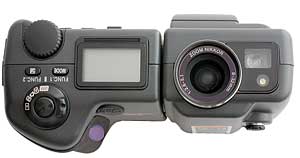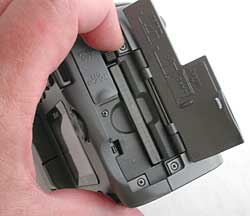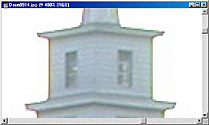last update: July 25, 2001
An evolutionary step in the Coolpix line. Unfortunately, the step is a small one.
When the feature list of the 995 first hit the net, it provoked a lot of head-scratching. Where was the increased pixel count? Where were the significant new features? Why did a handful of minor changes justify a new number (Nikon has previously simply added an S to the end of a model number when making minor changes)? On one major Coolpix newsgroup, a poll asking how many 990 users were planning on upgrading to a 995 revealed that virtually none were. The possible excitement of a new digital camera from Nikon was replaced by a giant, collective yawn.
That yawn was somewhat premature.
 |
If you haven't already read my Coolpix 990 review, please do so before looking at this one. Since the 996 shares 95% of the features of its predecessor, almost everything I wrote there is still relevant. In this review, I'll concentrate on the differences, and on the Coolpix 995's performance.
So what's different between the Coolpix 990 and 995? Well, here's a reasonably full list:
-
The body size and shape have changed. The 995 is a little deeper than the 990, and not quite as wide.
- The camera now uses a rechargeable lithium EN-EL1 (or 2CR5) battery instead of AA batteries. The camera comes with a charger and one battery.
- The flash head has been moved from next to the lens to a spring loaded pop-up. The TTL flash sensor has moved along with the flash head. Nikon claims the flash is slightly more powerful (GN of 32 [10m] versus 30 [9m]), but I'm not convinced. (Nikon has changed flash powers on similar units before merely based on different rounding calculations.)
- A "limit" lever has been added so that the swivel action won't go past a certain point (90 degrees).
- A Quick Review button has been added to the back of the camera, letting you invoke playback of images without leaving A-Rec or M-Rec shooting modes.
- The lens has been changed, adding 8mm's of reach at the telephoto end (now equivalent to a 38mm to 152mm lens on 35mm cameras).
- White balance can be bracketed (!).
- The CompactFlash slot now accepts Type II cards (though Nikon doesn't specifically endorse IBM Microdrives!)
- A new noise reduction feature subtracts a "dark noise" frame from long exposures.
- An auto transfer mode has been added for PC connections.
- The 995 has a slightly faster top shutter speed (1/2300 versus 1/1000).

Doesn't seem like much change when reduced to a list, does it?
Frankly, it's not the new features that impressed me as much subtle improvements to the overall image quality. Specifically, noise is considerably reduced, long exposures have fewer stray pixels, and color saturation and fidelity is improved.
Nikon punts on the Microdrive question. It isn't addressed in their manual, nor are these high-capacity cards mentioned on their Web sites or in marketing materials.
The Basics
The Coolpix 995, like the 990, is a very full featured digital camera. Nikon did a wise thing and didn't fool with a winner. Short of interchangeable lenses, a flash hot shoe, and a raw file mode, there isn't much that's missing in the specification box.
One thing that doesn't get mentioned in most reviews of the Coolpix cameras is the manual. The manual that came with the 990 was adequate, though it didn't really discuss the why's and when's of using features. Apparently Nikon thought the manual lacking, as the 995's manual is all new. Unfortunately, that's not necessarily good news. First, the camera came with several errata sheets for the manual, indicating that the manual might have been rushed. Second, the six page "Menu Guide" (42 itty-bitty screen shots that attempt to show the structure of the menuing system and serve as a TOC to the rest of the manual) is, well, not much of a guide. That's especially true since several of the errata relate to those pages.
Handling
I've been shooting with a Coolpix 9xx model for over two years. Each new iteration has added features, but each model has also added complexity and contradictions. So a warning: if you don't want to take time to read a 179-page manual, don't have time to experiment with camera settings, and you aren't willing to suffer a few miscues along the way, the Coolpix 995 isn't for you (I'd suggest the 880).
Unfortunately, Nikon didn't exactly get everything right in the transition from 990 to 995. I haven't seen most of these annoying changes discussed in other reviews, by the way, so I'll spend a bit more verbiage discussing them here. For example:
- The
eject button on the CompactFlash slot is hard to get to. On
the 990, the fold-out eject button was at the bottom of card slot and
had a larger cutout above it to allow your finger to reach in and fold
out the button. On the 995, the eject button is at the top of the card
slot, and there's less room to get your finger in to fold the button
out. If you've got fat or large fingers, you'll object to the change.
The problem went from bad on the 990 to worse on the 995.

- The strap positions have moved to assymetrical positions on the edge of the case (on the back side). The 990 hung from your neck in a better balanced position than does the 995. I also don't like the fact that this tends to push the strap towards the camera user when hanging slack. On the 990, the strap tending to hang to the side, out of the way, when slack.
- The extended front grip sticks out less from the body, but it extends wider. If you've got a small hand, as I do, you'll much prefer the 990's narrower grip. It's a lot easier to "lock onto" the 990's grip than it is the 995. (And yes, we've got the same glued-on rubber grip on the front, which has a notorious reputation for coming loose and needed remounting.)
- The
battery compartment door and tripod mounting positions have changed
relationship once again (the fourth time in the twist and shoot
body design), making for the need of yet another mounting plate for
those of us who use quick mounts. Moreover, the 995's battery door has
a curved bit that extends further towards the tripod mounting hole,
thus requiring an absolutely custom plate with almost no extension on
one side of the tripod hole (I was able to use a common lens plate on
the 990). Yuck.
- The pop-up flash raises a whole 2" above the lens center, ostensibly to improve red eye. Sorry, Nikon, but the formula for determining red eye is X = ( Y / 2 ) / tan(a) where: X is the camera-to-subject distance, Y is the height of the flash above the lens, and a is 2.5 degrees. So by positioning the flash 2" above the lens, red eye has been eradicated all the way out to 25 inches. I don't know about you, but I haven't taken many pictures of people when they've been less than two feet away from me. The "TTL" sensor moved with the flash head, but it didn't move far enough to clear the current available Nikon lens converters. Stupid.
- The new lever that limits the swivel action of the camera (yes!) is poorly placed (no!). If you use the 995 on a tripod, you won't be able to access the limit lever. Frankly, the only time I'd want to use the limit lever is when the camera is on a tripod. Worse still, those of us who use quick mount plates on our cameras must tolerate never being able to use it. The limit lever should be on the lower front portion of the camera, just below Nikon's logo. Further, it should be an absolute lock on the swivel action, not just a limiter.
- Spanish has been added as a supported language. Besides German, French, English, and Japanese, you can set the 995's menuing system to Spanish. Mucho gracias.
- Here's a silly one: Nikon has replaced the "REC" that is stenciled between the A and M positions of the camera mode switch with a camera icon. Yes, that makes everything crystal clear, doesn't it? The first time I saw it, I wanted to set the switch to the "camera icon position" to see what that did. Why can't we just have A, M, and Play?
A couple of things Nikon should have fixed, but didn't:
- The viewfinder still shows far too little of the frame (85%), and it still has parallax in two dimensions (with the flash out of the way, the viewfinder could have been flip-flopped to be centered at the same horizontal position as the lens). Lens converters still block the viewfinder.
- The DC In socket is still on the front of the camera, where cables tend to snake into your picture at inopportune times.
- The messages and menus are still a bit too Japalish (or is Englinese?). Consider the following message: "1 Erase Images Yes or No?" (and the selectable options then appear in the order of No followed by Yes). Sure, we all know what the camera means, but you'll find yourself looking at some messages a couple of times just to make sure it means what you think it means.
- Button overload still impairs shooting styles. Shooting macro focus shots with the self timer set? Well, you'll get to press the focus button three times after every shot just to get those settings back. Even if I agreed with Nikon's decision to cancel the self timer after every shot, why should close up focus get canceled? (By the way, the manual forgets to tell you that the self timer cancels itself after each shot.)
Then there's the EN-EL1 lithium battery. On the plus side, you get a rechargeable battery and a compact charger unit. And lithium batteries do better in cold weather than alkaline or Nimh. Also, in a pinch, you can use an expensive 2CR5 battery (not easy to find while traveling) while waiting for your EN-EL1 to recharge. On the down side, Nikon's price for additional batteries is about triple what a set of rechargeable AA Nimh batteries would cost you, and you can't sub in easy-to-find AA batteries in a pinch. The battery changeover was a simultaneous step forward and backward, in my opinion.
Nikon also got a few new things wrong:
- If you use an external Speedlight, the internal flash must be popped up, even if the internal flash has been turned off via the menus. This is because the flash sensor is on the pop-up portion of the flash.
- White Balance bracketing is in the bracketing menu, which means that you can set exposure bracketing or white balance bracketing, but not both. Not that I can think of a situation where I'd want to do that, but Nikon continues to group features together in ways that ultimately limit what a user can do. I'd much prefer independent features, especially since the Coolpix supports the ability to hold multiple settings in User Sets.
- The MH-51 battery charger supplied with the camera doesn't act as an AC supply. But the EH-21 AC adapter can charge the EN-EL1 battery. This is absolutely silly marketing on Nikon's part. I'd prefer to have paid a few dollars more and received both the AC and charging abilities.
Product Specification
|
CCD
|
3.34
megapixel 1/2" CCD
|
|
Image
Sizes
|
2048
x 1536, 2048 x 1360, 1600 x 1200, 1280 x 960, 1024 x 768, 640
x 480
|
| Lens | 8-32mm f/2.6-5.1 (38 - 152mm 35mm film equivalent) (plus 4x digital zoom) |
| Focus | 5-area autofocus, spot autofocus, 50-step manual focus; close focus at middle zoom position ranges from 0.8" (2cm) to infinity. |
| Storage | Type 1 or Type II CompactFlash card (16MB card supplied) |
| Shutter | 8 second to 1/2300 second (some limitations in various exposure modes), plus 60-second bulb. |
| ISO | Auto, ISO 100, 200, 400, or 800 |
| Flash | Built-in TTL Speedlight with GN of 32 (10m). Slow sync, red-eye reduction, flash exposure compensation, and external Speedlights supported (requires optional sync terminal cord) |
| Connections | USB, Video (NTSC or PAL, user selectable) |
| Battery | Li-ion rechargeable (EN-EL1) included (Nikon claims the battery is good for about 220 frames or 110 minutes) |
| Viewfinder | 1.8" 110,000 dot color LCD shows 97% coverage, optical viewfinder shows 85% |
| US product includes | Camera, EN-EL1 battery, battery charger, USB cable, video cable, 16MB CompactFlash card, camera strap, lens cap, instruction manual, Nikon View 4 CD |
|
Size
and Weight
|
5.4
x 3.2 x 1.6" (138 x 82 x 40mm), 13.8 ounces (390g)
|
|
Price
|
US$899
(street)
|

Let's take
a close look at how the 995 does. Here's a shot at the widest zoom taken
in very difficult lighting. The metering is pretty much dead on, despite
the intense backlight (the sun is just barely out of the picture).

Here's a 400% look at the steeple in the background. There's good sharpness,
but look at the left and right edges. Once again, our old friend chromatic
aberration strikes in high contrast situations, with the left side going
purple/red, the right going green. Basically, this is the same performance
seen in the 990. If it weren't for the color shifts on edges, the Coolpix
995 would give the professional digital cameras a real run for the money.

On the other hand, the 995's lens is darn sharp in regular contrast situations.
The sharpness is so acute, that it's easy to tell that these are plastic
flowers. Indeed, the detail on the green "leaves" is nothing
short of spectacular, with only digital aliasing visible.

At full telephoto,
there's just a bit of pincushion distortion, but the image is very sharp
and contrasty. Very little loss of sharpness is evident in the corners,
and I'd say the overall sharpness is the best of any Coolpix to date.

Unfortunately,
zoomed fully to the wide position, the lens shows a great deal of barrel
distortion. There's measurable light falloff in the corners, and the corners
are distinctly softer than the middle. This is the same poor performance
we've seen with the Coolpix 950 and 990, and the corner performance gets
worse at close distances.
Color fidelity at any focal length is nearly perfect. The telephoto image, once I sampled the white point, is as close to identical to my test chart as I've seen. (My sample point on the wide angle appears to have picked up a touch of light falloff--that's probably my fault, not the camera's.)
Exposure
The
Coolpix 995 has all the pluses and minuses of Nikon's metering system.
For most situations, the matrix meter is perfect. In a high contrast
situation, there's a tendency towards underexposure of centrally located
subjects.
Color Rendition
The colors in a Coolpix 995 image look more subtle than those of the 990. Part of this is the very evident lower noise level. Shadow detail has less of a tendency to pick up blue or red channel noise, thus the shadows degrade to black very naturally.
Bright detail doesn't fare as well. It's very difficult to expose in a way that preserves highlight detail. In almost every case, you're better off underexposing slightly and using Levels or Curves to lighten the highlights. The 990 was very slightly better at rendering bright areas at the proper exposure, but not enough to warrant giving up the other pluses the 995 provides.
-
Lens still has defects. The redesigned lens, while giving more telephoto reach, still has very visible barrel distortion and chromatic aberration. Both keep the Coolpix line from seriously crossing over into the pro world. And frankly, neither should be present on a US$900 camera. If I had time and money to spare, I'd pull the lens out of my Coolpix and install a C mount. Sure I'd lose autofocus and automatic aperture setting, but I bet you the resulting images would be substantially better.
-
Flash hasn't really improved. The pop-up flash really doesn't solve any problem well, and the TTL sensor is still blocked by most lens converters, forcing you to use an external Speedlight. Useful flash settings are still buried in menus.

-
The color LCD still isn't visible in bright light. The folks at Hoodman should rejoice, as Nikon still can't seem to figure out how to get an anti-reflective coating and daylight viewing into their LCD. Canon and other cameras have better color LCDs, IMHO. Curiously, Nikon sells a Nikon-logoed hood accessory in Japan, but doesn't sell it anywhere else in the world.
- Excellent FINE JPEGs. Plenty of resolution to print 8x10" prints, and the color fidelity is excellent. JPEG artifacts at the Fine setting are minimal. Color fidelity is improved over the 990, as is saturation of some colors, such as yellows. Shadow detail is better, and noise is far less present.
- Feature-rich
camera. You can play the all-automatic game, or you can manually
control virtually every feature, including things that professionals
look for, such as flash fill levels. The extra telephoto oomph gets
rid of one weakness of the Coolpix line and actually forces you to pay
attention to depth of field.

Here's another example that reveals just how well the 995 does: the shadow
areas are so free from digital noise there's almost a film-like quality
to them (note, I said almost). Again, the lens performance holds
the 995 back--virtually all the defects I can find when examing this image
at 800% are lens-induced. Still, remarkably good performance for a consumer
camera.
Recommended, this Coolpix sits at the top of the prosumer digital camera heap.
![]()
![]()
![]()
![]()
![]() features
features
![]()
![]()
![]()
![]()
![]() performance
performance
![]()
![]()
![]()
![]()
![]() build
build
![]()
![]()
![]()
![]()
![]() value
value
